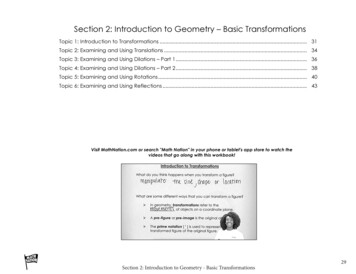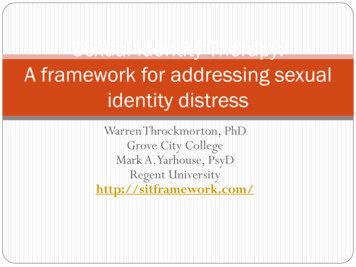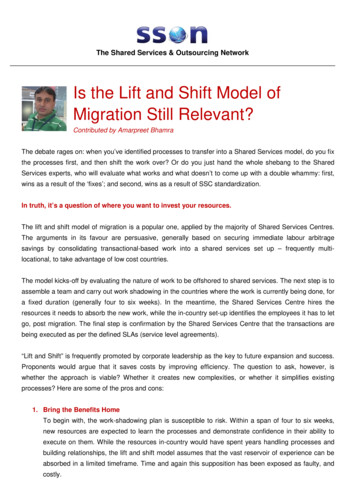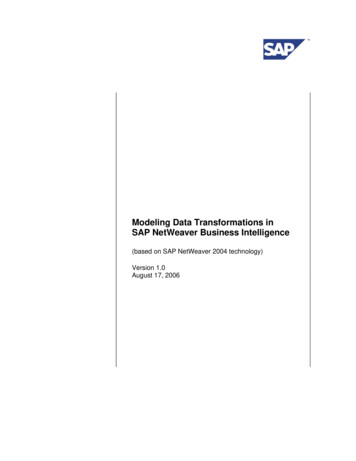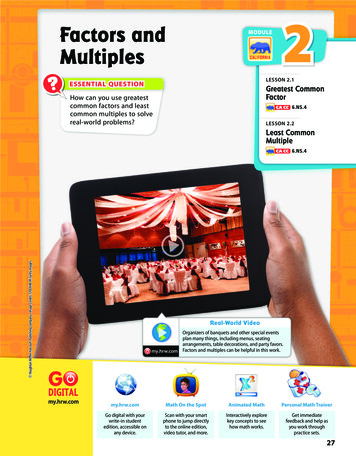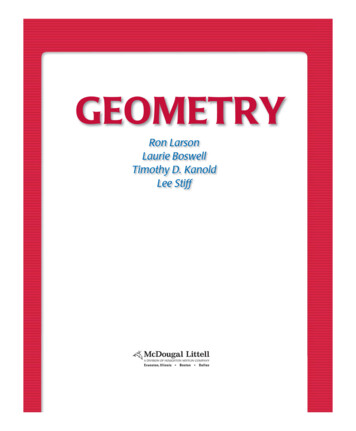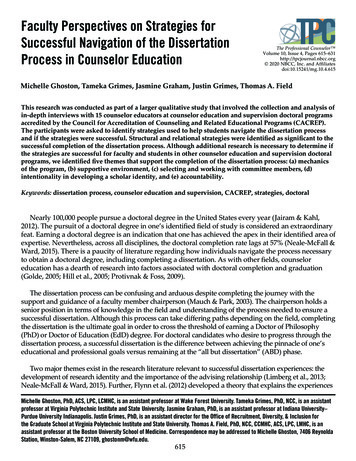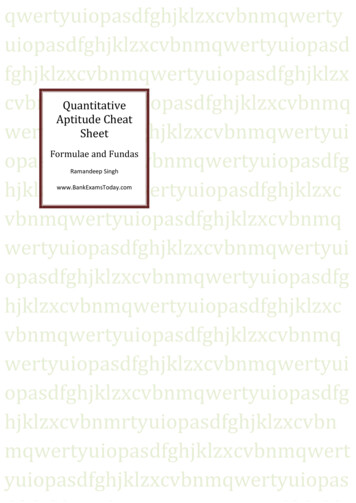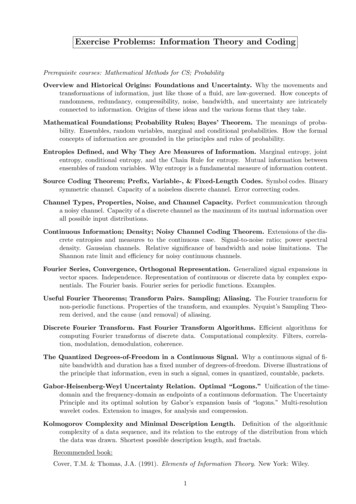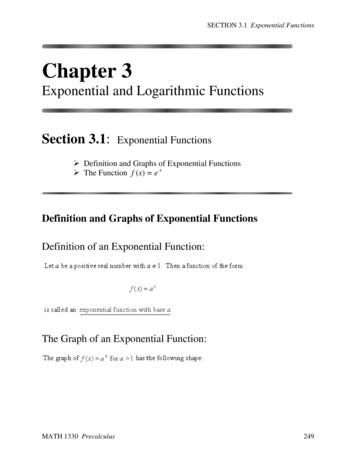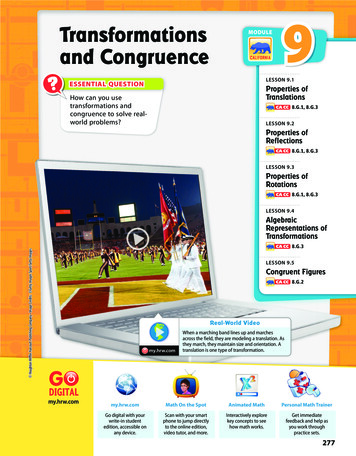
Transcription
Transformationsand Congruence?MODULE9LESSON 9.1ESSENTIAL QUESTIONProperties ofTranslationsHow can you usetransformations andcongruence to solve realworld problems?8.G.1, 8.G.3LESSON 9.2Properties ofReflections8.G.1, 8.G.3LESSON 9.3Properties ofRotations8.G.1, 8.G.3LESSON 9.4AlgebraicRepresentations ofTransformations Houghton Mifflin Harcourt Publishing Company Image Credits: Getty Images Sport/Getty Images8.G.3LESSON 9.5Congruent Figures8.G.2Real-World Videomy.hrw.commy.hrw.comWhen a marching band lines up and marchesacross the field, they are modeling a translation. Asthey march, they maintain size and orientation. Atranslation is one type of transformation.my.hrw.comMath On the SpotAnimated MathPersonal Math TrainerGo digital with yourwrite-in studentedition, accessible onany device.Scan with your smartphone to jump directlyto the online edition,video tutor, and more.Interactively explorekey concepts to seehow math works.Get immediatefeedback and help asyou work throughpractice sets.277
Are YOU Ready?PersonalMath TrainerComplete these exercises to review skills you will needfor this module.Integer Operationsmy.hrw.com-3 - (-6) -3 6EXAMPLEOnline Practiceand HelpTo subtract an integer, add its opposite.The signs are different, so find thedifference of the absolute values: 6 - 3 3.Use the sign of the number with the greaterabsolute value. -3 - 6 3Find each difference.1. 5 - (-9)2. -6 - 83. 2 - 94. -10 - (-6)5. 3 - (-11)6. 12 - 77. -4 - 118. 0 - (-12)Measure AnglesJ0120 6013 0511070100 90 80 7100 1 08010612 00513 001020 17030 0 160540 0 11417010 160 120530 0 1440 0LKm JKL 70 Place the center point of theprotractor on the angle’s vertex.Align one ray with the base of theprotractor.Read the angle measure where theother ray intersects the semicircle.Use a protractor to measure each angle.9.10.FH11.XRGYZS278Unit 4T Houghton Mifflin Harcourt Publishing CompanyEXAMPLE
Reading Start-UpVisualize VocabularyUse the words to complete the graphic organizer. You will putone word in each oval.Types of QuadrilateralsVocabularyReview Wordscoordinate plane (planocartesiano) parallelogram(paralelogramo)quadrilateral (cuadrilátero) rhombus (rombo) trapezoid (trapecio)Preview WordsA quadrilateralin which allsides arecongruent andopposite sidesare parallel.A quadrilateral inwhich oppositesides are paralleland congruent.A quadrilateralwith exactly onepair of parallelsides.Understand Vocabularycenter of rotation (centrode rotación)congruent (congruente)image (imagen)line of reflection (línea dereflexión)preimage (imagenoriginal)reflection (reflexión)rotation ion (traslación) Houghton Mifflin Harcourt Publishing CompanyMatch the term on the left to the correct expression on the right.1. transformationA. A function that describes a change in theposition, size, or shape of a figure.2. reflectionB. A function that slides a figure along astraight line.3. translationC. A transformation that flips a figure across a line.Active ReadingBooklet Before beginning the module, createa booklet to help you learn the concepts in thismodule. Write the main idea of each lesson oneach page of the booklet. As you study eachlesson, write important details that support themain idea, such as vocabulary and formulas.Refer to your finished booklet as you work onassignments and study for tests.Module 9279
GETTING READY FORTransformations and CongruenceUnderstanding the standards and the vocabulary terms in the standardswill help you know exactly what you are expected to learn in this module.Understand that a twodimensional figure is congruentto another if the second canbe obtained from the firstby a sequence of rotations,reflections, and translations;given two congruent figures,describe a sequence thatexhibits the congruencebetween them.What It Means to YouYou will identify a rotation, a reflection, a translation, and asequence of transformations, and understand that the imagehas the same shape and size as the preimage.EXAMPLE 8.G.2The figure shows triangleABC and its image after threedifferent transformations.Identify and describe thetranslation, the reflection, andthe rotation of triangle ABC.Figure 1 is a translation 4 unitsdown. Figure 2 is a reflectionacross the y-axis. Figure 3 is arotation of 180 .8.G.3Describe the effect of dilations,translations, rotations, andreflections on two-dimensionalfigures using coordinates.yFigure 2B′A′4AB2-4B′C′C′Figure 3A′ C B′O2-2A′C′x4Figure 1What It Means to YouYou can use an algebraic representation to translate, reflect, orrotate a two-dimensional figure.EXAMPLE 8.G.3Rectangle RSTU with vertices (-4, 1), (-1, 1), (-1, -3), and (-4, -3)is reflected across the y-axis. Find the coordinates of the image.The rule to reflect across the y-axis is to change the sign of thex-coordinate.Visit my.hrw.comto see all CACommon CoreStandardsexplained.my.hrw.com280Unit 4CoordinatesReflect across they-axis (-x, y)(-4, 1), (-1, 1),(-(-4), 1), (-(-1), 1),Coordinatesof image(4, 1), (1, 1),(-1, -3), (-4, -3) (- (-1), -3), (-(-4), -3) (1, -3), (4, -3)The coordinates of the image are (4, 1), (1, 1), (1, -3), and (4, -3). Houghton Mifflin Harcourt Publishing Company8.G.2
LESSON9.1?Propertiesof TranslationsESSENTIAL QUESTION8.G.1aVerify experimentally theproperties of rotations,reflections, and translations:Lines are taken to lines,and line segments to linesegments of the same length.Also 8.G.1b, 8.G.1c, 8.G.3How do you describe the properties of translation and theireffect on the congruence and orientation of figures?EXPLORE ACTIVITY 18.G.1aExploring TranslationsYou learned that a function is a rule that assigns exactly one output toeach input. A transformation is a function that describes a change inthe position, size, or shape of a figure. The input of a transformation isthe preimage, and the output of a transformation is the image.A translation is a transformation that slides a figure along astraight line.The triangle shown on the grid is the preimage (input). The arrowshows the motion of a translation and how point A is translatedto point A′.yª )PVHIUPO .JGGMJO )BSDPVSU 1VCMJTIJOH PNQBOZ t *NBHF SFEJUT ª#SBOE 9 1JDUVSFT "MBNZ *NBHFTA Trace triangle ABC and line AA′ onto a piece of paper.B Slide your triangle along the line to model the translationthat maps point A to point A′.C The image of the translation is the triangle produced bythe translation. Sketch the image of the translation.D The vertices of the image are labeled using primenotation. For example, the image of A is A′. Label theimages of points B and C.E Describe the motion modeled by the translation.Moveunits right andA1086CA′B42xO246810units down.F Check that the motion you described in part E is the same motionthat maps point A onto A′, point B onto B ′, and point C onto C ′.Reflect1.How is the orientation of the triangle affected by the translation?Lesson 9.1281
EXPLORE ACTIVITY 28.G.1aProperties of TranslationsUse trapezoid TRAP to investigate the propertiesof translations.y6A Trace the trapezoid onto a piece of paper.Cut out your traced trapezoid.B Place your trapezoid on top of thetrapezoid in the figure. Then translate yourtrapezoid 5 units to the left and 3 unitsup. Sketch the image of the translation bytracing your trapezoid in this new location.Label the vertices of the image T ′, R ′, A′,and P ′.42-6-4TO-2xR26-2-4PA-6C Use a ruler to measure the sides of trapezoidTRAP in centimeters.TR RA AP TP D Use a ruler to measure the sides of trapezoid T ′R ′A′P ′ in centimeters.T ′R ′ R ′A′ A′P ′ T ′P ′ E What do you notice about the lengths of corresponding sides ofthe two figures?F Use a protractor to measure the angles of trapezoid TRAP.m T m R m A m P G Use a protractor to measure the angles of trapezoid T ′R ′A′P ′.m R ′ m A′ m P ′ H What do you notice about the measures of corresponding angles ofthe two figures?I Which sides of trapezoid TRAP are parallel? How do you know?Which sides of trapezoid T ′R ′A′P ′ are parallel?What do you notice?282Unit 4 Houghton Mifflin Harcourt Publishing Companym T ′
Reflect2.Make a Conjecture Use your results from partsa conjecture about translations.3.Two figures that have the same size and shape are called congruent. Whatcan you say about translations and congruence?E,H, andIto makeGraphing TranslationsTo translate a figure in the coordinate plane, translate each of its vertices. Thenconnect the vertices to form the image.Math On the SpotEXAMPL 1EXAMPLE8.G.3my.hrw.comThe figure shows triangle XYZ. Graph the image of the triangle after atranslation of 4 units to the right and 1 unit up.STEP 1yTranslate point X.5Count right 4 units and up1 unit and plot point X ′.STEP 2Translate point Y.Count right 4 units and up1 unit and plot point Y ′. Houghton Mifflin Harcourt Publishing CompanySTEP 3X′XO-5YY′5xZ′ZTranslate point Z.-5Math TalkCount right 4 units and up1 unit and plot point Z ′.STEP 4Mathematical PracticesyConnect X ′, Y ′, and Z ′ to formtriangle X ′Y ′Z ′.5X′XO-5Each vertex is moved 4units right and 1 unit up.Is the image congruentto the preimage? How doyou know?Y′5YxZ′Z-5Lesson 9.1283
yYOUR TURNPersonalMath TrainerOnline Practiceand Helpmy.hrw.com4. The figure shows parallelogramABCD. Graph the image of theparallelogram after a translationof 5 units to the left and 2 unitsdown.4ABxO-6DC6-4Guided Practice1. Vocabulary Asize, or shape of a figure.is a change in the position,2. Vocabulary When you perform a transformation of a figure onthe coordinate plane, the input of the transformation is calledthecalled the, and the output of the transformation is.3. Joni translates a right triangle 2 units down and 4 units to the right.How does the orientation of the image of the triangle compare with theorientation of the preimage? (Explore Activity 1)y5. The figure shows trapezoid WXYZ. Graph the image of thetrapezoid after a translation of 4 units up and 2 units tothe left. (Example 1)?xESSENTIAL QUESTION CHECK-IN6. What are the properties of translations?2844Unit 4-5OWXZ-4Y5 Houghton Mifflin Harcourt Publishing Company4. Rashid drew rectangle PQRS on a coordinate plane. He then translatedthe rectangle 3 units up and 3 units to the left and labeled the imageP ′Q ′R ′S ′. How do rectangle PQRS and rectangle P ′Q ′R ′S ′ compare?(Explore Activity 2)
NameClassDate9.1 Independent PracticePersonalMath Trainer8.G.1a, 8.G.1b, 8.G.1c, 8.G.3my.hrw.comOnline Practiceand Helpy7. The figure shows triangle DEF.6a. Graph the image of the triangle after the translationthat maps point D to point D ′.EDb. How would you describe the translation?FO-6x6D′c. How does the image of triangle DEF compare withthe preimage?-4y8. a. Graph quadrilateral KLMN with vertices K(–3, 2),L(2, 2), M(0, –3), and N(–4, 0) on the coordinate grid.6b. On the same coordinate grid, graph the image ofquadrilateral KLMN after a translation of 3 units tothe right and 4 units up.c. Which side of the image is congruent to side LM?xO-66Name three other pairs of congruent sides.-6 Houghton Mifflin Harcourt Publishing CompanyDraw the image of the figure after each translation.9. 4 units left and 2 units down10. 5 units right and 3 units upyy66QPBR-6OSAx6O-6x6CD-6-6Lesson 9.1285
11. The figure shows the ascent of a hot air balloon. Howwould you describe the translation?4212. Critical Thinking Is it possible that the orientation of afigure could change after it is translated? Explain.-4-242-4FOCUS ON HIGHER ORDER THINKING13. a. Multistep Graph triangle XYZ with vertices X(–2, –5),Y(2, –2), and Z(4, –4) on the coordinate grid.y6b. On the same coordinate grid, graph and labeltriangle X ′Y ′Z ′, the image of triangle XYZ after atranslation of 3 units to the left and 6 units up.x-6d. Analyze Relationships How would you describethe translation that maps triangle XYZ onto triangleX ′′Y ′′Z ′′?y6-6O-6286Unit 46-614. Critical Thinking The figure shows rectangle P ′Q ′R ′S ′,the image of rectangle PQRS after a translation of5 units to the right and 7 units up. Graph and labelthe preimage PQRS.15. Communicate Mathematical Ideas Explain why theimage of a figure after a translation is congruent to itspreimage.OP′Q′S′R′x6 Houghton Mifflin Harcourt Publishing Companyc. Now graph and label triangle X ′′Y ′′Z ′′, the image oftriangle X ′Y ′Z ′ after a translation of 1 unit to the leftand 2 units down.
LESSON9.2?Properties ofReflections8.G.1bVerify experimentally theproperties of rotations,reflections, and translations:Angles are taken to anglesof the same measure. Also8.G.1a, 8.G.1c, 8.G.3ESSENTIAL QUESTIONHow do you describe the properties of reflection and their effecton the congruence and orientation of figures?EXPLORE ACTIVITY 18.G.1bExploring ReflectionsA reflection is a transformation that flips a figure across a line.The line is called the line of reflection. Each point and its imageare the same distance from the line of reflection.yThe triangle shown on the grid is the preimage. You willexplore reflections across the x- and y-axes.6A Trace triangle ABC and the x- and y-axes onto a piece ofpaper.B Fold your paper along the x-axis and trace the image ofthe triangle on the opposite side of the x-axis. Unfold yourpaper and label the vertices of the image A′, B ′, and C ′.ACBxO-66ª )PVHIUPO .JGGMJO )BSDPVSU 1VCMJTIJOH PNQBOZ t *NBHF SFEJUT ª(FUUZ *NBHFT 1IPUPEJTDC What is the line of reflection for this transformation?-6D Find the perpendicular distance from each point to theline of reflection.Point APoint BPoint CE Find the perpendicular distance from each point to the line of reflection.Point A'Point B 'Point C 'F What do you notice about the distances you found inDandE?Reflect1. Fold your paper from A along the y-axis and trace the image oftriangle ABC on the opposite side. Label the vertices of the imageA″, B″, and C″. What is the line of reflection for this transformation?2. How does each image in your drawings compare with its preimage?Lesson 9.2287
EXPLORE ACTIVITY 28.G.1bProperties of ReflectionsyUse trapezoid TRAP to investigate the propertiesof reflections.TRA Trace the trapezoid onto a piece of paper. Cut outyour traced trapezoid.B Place your trapezoid on top of the trapezoid in thefigure. Then reflect your trapezoid across the y-axis.Sketch the image of the reflection by tracing yourtrapezoid in this new location. Label the vertices ofthe image T ′, R ′, A′, and P ′.6AxPO-66-4C Use a ruler to measure the sides of trapezoid TRAP in centimeters.TR RA AP TP D Use a ruler to measure the sides of trapezoid T ′R ′A′P ′ in centimeters.T ′R ′ R ′A′ A′P ′ T ′P ′ E What do you notice about the lengths of corresponding sides ofthe two figures?F Use a protractor to measure the angles of trapezoid TRAP.m T m R m A m P m T ′ m R ′ m A′ m P ′ H What do you notice about the measures of corresponding angles of thetwo figures?I Which sides of trapezoid TRAP are parallel?Which sides of trapezoid T ′R ′A′P ′ are parallel?What do you notice?288Unit 4 Houghton Mifflin Harcourt Publishing CompanyG Use a protractor to measure the angles of trapezoid T ′R ′A′P ′.
Reflect3. Make a Conjecture Use your results fromconjecture about reflections.E,H, andIto make aMath TalkMathematical PracticesWhat can yousay about reflectionsand congruence?Graphing ReflectionsTo reflect a figure across a line of reflection, reflect each of its vertices. Thenconnect the vertices to form the image. Remember that each point and itsimage are the same distance from the line of reflection.Math On the Spotmy.hrw.comEXAMPL 1EXAMPLE8.G.3The figure shows triangle XYZ. Graph the image of the triangle after areflection across the x-axis.STEP 1yReflect point X.6Point X is 3 units below thex-axis. Count 3 units abovethe x-axis and plot point X′ .STEP 2Reflect point Y.Point Y is 1 unit below thex-axis. Count 1 unit abovethe x-axis and plot point Y ′. Houghton Mifflin Harcourt Publishing CompanySTEP 3X'3-6OXPoint Z is 5 units below thex-axis. Count 5 units abovethe x-axis and plot point Z ′.STEP 4x5ZyConnect X ′, Y ′, and Z ′ to formtriangle X ′Y ′Z ′.Each vertex of the imageis the same distancefrom the x-axis as thecorresponding vertex inthe original figure.35Y'1Y 1-6Reflect point Z.My NotesZ'6Z'X'-6xY'OY6X-6ZLesson 9.2289
yYOUR TURNPersonalMath TrainerOnline Practiceand HelpBA4. The figure shows pentagonABCDE. Graph the image of thepentagon after a reflection acrossthe y-axis.6CxDE-6my.hrw.comO6-6Guided Practice1. Vocabulary A reflection is a transformation that flips a figure acrossa line called the.2. The figure shows trapezoid ABCD. (Explore Activities 1 and 2 and Example 1)ya. Graph the image of the trapezoid after a reflectionacross the x-axis. Label the vertices of the image.6BDc. What If? Suppose you reflected trapezoid ABCDacross the y-axis. How would the orientation ofthe image of the trapezoid compare with theorientation of the preimage?-6-6?ESSENTIAL QUESTION CHECK-IN3. What are the properties of reflections?290Unit 4xCO6 Houghton Mifflin Harcourt Publishing CompanyAb. How do trapezoid ABCD and trapezoid A'B'C'D'compare?
NameClassDate9.2 Independent PracticePersonalMath Trainer8.G.1a, 8.G.1b, 8.G.1c, 8.G.3my.hrw.comThe graph shows four right triangles. Use thegraph for Exercises 4–7.y8. a. Graph quadrilateral WXYZ withvertices W(-2, -2), X(3, 1), Y(5, -1),and Z(4, -6) on the coordinate grid.y6AOnline Practiceand HelpB462x-6-4-2O24-2C-4X6-6DxOY6W-6-64. Which two triangles are reflections of eachother across the x-axis?5. For which two triangles is the line ofreflection the y-axis? Houghton Mifflin Harcourt Publishing Company6. Which triangle is a translation of triangle C?How would you describe the translation?7. Which triangles are congruent? How doyou know?Zb. On the same coordinate grid, graphquadrilateral W′X′Y′Z′, the image ofquadrilateral WXYZ after a reflectionacross the x-axis.c. Which sideof the image is congruentto side YZ?Name three other pairs of congruentsides.d. Which angle of the image is congruentto X?Name three other pairs of congruentangles.Lesson 9.2291
9. Critical Thinking Is it possible that the image of a point after a reflectioncould be the same point as the preimage? Explain.FOCUS ON HIGHER ORDER THINKINGy10. a. Graph the image of the figure shown after a reflectionacross the y-axis.5b. On the same coordinate grid, graph the image of the figureyou drew in part a after a reflection across the x-axis.xO-5c. Make a Conjecture What other sequence oftransformations would produce the same final imagefrom the original preimage? Check your answer byperforming the transformations. Then make a conjecturethat generalizes your findings.-5y11. a. Graph triangle DEF with vertices D(2, 6), E(5, 6), andF(5, 1) on the coordinate grid.6b. Next graph triangle D ′E ′F ′, the image of triangleDEF after a reflection across the y-axis.d. Analyze Relationships Find a different sequenceof transformations that will transform triangle DEFto triangle D ′′E ′′F ′′.292Unit 4DE42xF-6-4-2O-2-4-6246 Houghton Mifflin Harcourt Publishing Companyc. On the same coordinate grid, graph triangle D′′ E′′ F′′,the image of triangle D′E′F′ after a translation of7 units down and 2 units to the right.5
LESSON9.3?Properties ofRotationsESSENTIAL QUESTION8.G.1cVerify experimentally theproperties of rotations,reflections, and translations:Parallel lines are taken toparallel lines. Also 8.G.1a,8.G.1b, 8.G.3How do you describe the properties of rotation and their effect onthe congruence and orientation of figures?EXPLORE ACTIVITY 18.G.1cExploring RotationsA rotation is a transformation that turns a figure around a givenpoint called the center of rotation. The image has the same sizeand shape as the preimage.The triangle shown on the grid is the preimage. You will usethe origin as the center of rotation.A Trace triangle ABC onto a piece of paper. Cut out yourtraced triangle.y5B Rotate your triangle 90 counterclockwise about theorigin. The side of the triangle that lies along the x-axisshould now lie along the y-axis.ª )PVHIUPO .JGGMJO )BSDPVSU 1VCMJTIJOH PNQBOZ t *NBHF SFEJUT ª*,0 'PUPMJBC Sketch the image of the rotation. Label the images ofpoints A, B, and C as A′, B′, and C′.CAxB-55D Describe the motion modeled by the rotation.Rotateabout the origin.degrees-5E Check that the motion you described in D is the same motion thatmaps point A onto A′, point B onto B′, and point C onto C′.Reflect1.Communicate Mathematical Ideas How are the size and theorientation of the triangle affected by the rotation?2.Rotate triangle ABC 90 clockwise about the origin. Sketch the resulton the coordinate grid above. Label the image vertices A″, B″, and C″.Lesson 9.3293
EXPLORE ACTIVITY 28.G.1cProperties of RotationsUse trapezoid TRAP to investigate the properties of rotations.yA Trace the trapezoid onto a piece of paper.Include the portion of the x- and y-axesbordering the third quadrant. Cut out yourtracing.B Place your trapezoid and axes on top of thosein the figure. Then use the axes to help rotateyour trapezoid 180 counterclockwise aboutthe origin. Sketch the image of the rotation ofyour trapezoid in this new location. Label thevertices of the image T′, R′, A′, and P′.6C Use a ruler to measure the sides of trapezoidTRAP in centimeters.TR RA AP TP xO-6R-6T6APCut along lineafter tracing.D Use a ruler to measure the sides of trapezoid T′R′A′P′ in centimeters.T′R′ R′A′ A′P′ T′P′ E What do you notice about the lengths of corresponding sides of thetwo figures?F Use a protractor to measure the angles of trapezoid TRAP.m R m A m P G Use a protractor to measure the angles of trapezoid T′R′A′P′.m T′ m R′ m A′ m P′ H What do you notice about the measures of corresponding angles of thetwo figures?I Which sides of trapezoid TRAP are parallel?Which sides of trapezoid T′R′A′P′ are parallel?What do you notice?294Unit 4 Houghton Mifflin Harcourt Publishing Companym T
Reflect3.Make a Conjecture Use your results fromconjecture about rotations.4.Place your tracing back in its original position. Then perform a 180 clockwise rotation about the origin. Compare the result with the result inE,H, andto make aIB.Graphing RotationsTo rotate a figure in the coordinate plane, rotate each of its vertices. Thenconnect the vertices to form the image.Math On the SpotEXAMPL 1EXAMPLE8.G.3yThe figure shows triangle ABC. Graph theimage of triangle ABC after a rotation of90 clockwise.STEP 1Rotate the figure clockwise fromthe y-axis to the x-axis. Point Awill still be at (0, 0).5B Houghton Mifflin Harcourt Publishing CompanyC2-5-25AnimatedMathmy.hrw.comC′Math TalkMathematical PracticesHow is the orientationof the triangle affectedby the rotation?yConnect A′, B′, and C′ to form theimage triangle A′B′C′.5BReflectIs the image congruent to thepreimage? How do you know?2-5Point C is 2 units to the right ofthe y-axis, so point C′ is 2 unitsbelow the x-axis.5.B′xAA′-2Point B is 2 units to the left ofthe y-axis, so point B′ is 2 unitsabove the x-axis.STEP 2my.hrw.comC2-5-2AA′-2B′x25C′-5Lesson 9.3295
YOUR TURNyGraph the image of quadrilateral ABCDafter each rotation.PersonalMath TrainerOnline Practiceand Help56. 180 my.hrw.comB7. 270 clockwiseCx8. Find the coordinates of Point C after a90 counterclockwise rotation followedby a 180 rotation.A-5D5-5Guided Practice1. Vocabulary A rotation is a transformation that turns a figure around agivencalled the center of rotation.Siobhan rotates a right triangle 90 counterclockwise about the origin.2. How does the orientation of the image of the triangle compare with theorientation of the preimage? (Explore Activity 1)3. Is the image of the triangle congruent to the preimage? (Explore Activity 2)Draw the image of the figure after the given rotation about the origin. (Example 1)5. 180 y44-5?xEO-4F5GESSENTIAL QUESTION CHECK-IN6. What are the properties of rotations?296Unit 4y-5DO-4ABCx5 Houghton Mifflin Harcourt Publishing Company4. 90 counterclockwise
NameClassDate9.3 Independent PracticePersonalMath Trainer8.G.1a, 8.G.1b, 8.G.1c, 8.G.3my.hrw.comOnline Practiceand Helpy7. The figure shows triangle ABC and a rotation of the triangleabout the origin.C'a. How would you describe the rotation?5B'CA'O-55b. What are the coordinates of the image?,BA,x-58. The graph shows a figure and its image after atransformation.2a. How would you describe this as a rotation?-55-2b. Can you describe this as a transformation other than arotation? Explain.y9. What type of rotation will preserve the orientationof the H-shaped figure in the grid?3 Houghton Mifflin Harcourt Publishing Companyx10. A point with coordinates (-2, -3) is rotated 90 clockwiseabout the origin. What are the coordinates of its image?-3O3-3Complete the table with rotations of 180 or 90 . Include thedirection of rotation for rotations of 90 .Shape in quadrantImage in quadrant11.IIV12.IIII13.IVIIIRotationLesson 9.3297
Draw the image of the figure after the given rotation about the origin.14. 180 15. 270 counterclockwiseyy5CB-5xADC5BA-55-5Ox5-516. Is there a rotation for which the orientation of the image is always thesame as that of the preimage? If so, what?Work AreaFOCUS ON HIGHER ORDER THINKING17. Problem Solving Lucas is playing a game where he has to rotate a figurefor it to fit in an open space. Every time he clicks a button, the figurerotates 90 degrees clockwise. How many times does he need to click thebutton so that each figure returns to its original orientation?Figure AABCFigure B18. Make a Conjecture Triangle ABC is reflected across the y-axis to formthe image A′B′C′. Triangle A′B′C′ is then reflected across the x-axis to formthe image A″B″C″. What type of rotation can be used to describe therelationship between triangle A″B″C″ and triangle ABC?19. Communicate Mathematical Ideas Point A is on the y-axis. Describe allpossible locations of image A′ for rotations of 90 , 180 , and 270 . Includethe origin as a possible location for A.298Unit 4 Houghton Mifflin Harcourt Publishing CompanyFigure C
AlgebraicRepresentations ofTransformationsLESSON9.4?ESSENTIAL QUESTION8.G.3Describe the effect ofdilations, translations,rotations, and reflectionson two-dimensional figuresusing coordinates.How can you describe the effect of a translation, rotation, orreflection on coordinates using an algebraic representation?Algebraic Representationsof TranslationsThe rules shown in the table describe how coordinates change when a figure istranslated up, down, right, and left on the coordinate plane.Math On the Spotmy.hrw.comTranslationsRight a unitsAdd a to the x-coordinate: (x, y) (x a, y)Left a unitsSubtract a from the x-coordinate: (x, y) (x - a, y)Up b unitsAdd b to the y-coordinate: (x, y) (x, y b)Down b unitsSubtract b from the y-coordinate: (x, y) (x, y - b)EXAMPL 1EXAMPLE8.G.3 Houghton Mifflin Harcourt Publishing CompanyTriangle XYZ has vertices X(0, 0), Y(2, 3), and Z(4, -1). Find the vertices oftriangle X′Y′Z′ after a translation of 3 units to the right and 1 unit down.Then graph the triangle and its image.Add 3 to the x-coordinate of eachvertex and subtract 1 from they-coordinate of each vertex.STEP 1 Apply the rule to find the vertices of the image.STEP 2Vertices of XYZRule: (x 3, y - 1)Vertices of X′ Y′ Z′X(0, 0)(0 3, 0 - 1)X′(3, -1)Y(2, 3)(2 3, 3 - 1)Y′(5, 2)Z(4, -1)(4 3, -1 - 1)Z′(7, -2)Graph triangle XYZ and its image.y3XO-3YY′xX′Z7Z′Math TalkMathematical PracticesWhen you translate afigure to the left orright, which coordinatedo you change?Lesson 9.4299
YOUR TURNPersonalMath TrainerOnline Practiceand Help1.A rectangle has vertices at (0, -2), (0, 3), (3, -2), and (3, 3). What are thecoordinates of the vertices of the image after the translation(x, y) (x - 6, y - 3)? Describe the translation.my.hrw.comAlgebraic Representationsof ReflectionsMath On the Spotmy.hrw.comThe signs of the coordinates of a figure change when the figure is reflectedacross the x-axis and y-axis. The table shows the rules for changing the signsof the coordinates after a reflection.ReflectionsAcross the x-axisMultiply each y-coordinate by -1: (x, y) (x, -y)Across the y-axisMultiply each x-coordinate by -1: (x, y) (-x, y)EXAMPLE 2Rectangle RSTU has vertices R(-4, -1), S(-1, -1), T(-1, -3), and U(-4, -3).Find the vertices of rectangle R′S′T′U′ after a reflection acrossthe y-axis. Then graph the rectangle and its image.Multiply thex-coordinate ofeach vertex by -1.STEP 1 Apply the rule to find the vertices of the image.Vertices of RSTUR(-4, -1)Vertices of R′S′T′U′(-1 · (-1), - 1)S′(1, -1)(-1 · (-4), - 1)S(-1, -1)T(-1, -3)R′(4, -1)(-1 · (-1), - 3)U(-4, -3)STEP 2Rule: (-1 · x, y)T′(1, -3)(-1 · (-4), - 3)U′(4, -3)Graph rectangle RSTU and its image.y3x-5RSUTO-5300Unit 4S′5R′T′U′ Houghton Mifflin Harcourt Publishing CompanyMy Notes8.G.3
YOUR TURN2. Triangle ABC has vertices A(-2, 6), B(0, 5), and C(3, -1). Find the verticesof triangle A′B′C′ after a reflection across the x-axis.PersonalMath TrainerOnline Practiceand Helpmy.hrw.comAlgebraic Representations of RotationsWhen points are rotated about the origin, the coordinates of the image can befound using the rules shown in the table.Math On the SpotRotations90 clockwiseMultiply each x-coordinate by -1; then switchthe x- and y-coordinates: (x, y) (y, -x)90 counterclockwiseMultiply each y-coordinate by -1; then switchthe x- and y-coordinates: (x, y) (-y, x)180 Multiply both coordinates by -1: (x, y) (-x, -y)EXAMPL 3EXAMPLEmy.hrw.com8.G.3 Houghton Mifflin Harcourt Publishing CompanyQuadrilateral ABCD has vertices at A(-4, 2), B(-3, 4), C(2, 3), and D(0, 0).Find the vertices of quadrilateral A′B′C′D′ after a 90 clockwise rotation.Then graph the quadrilateral and its image.Multiply the x-coordinate ofeach vertex by -1, and thenswitch the x- and y-coordinates.STEP 1 Apply the rule to find the vertices of the image.STEP 2Vertices of ABCDRule: (y, -x)Vertices of A′B′C′D′A(-4, 2)(2, -1 · (-4))A′(2, 4)B(-3, 4)(4, -1 · (-3))B′(4, 3)C(2, 3)(3, -1
Aug 12, 2015 · Personal Math Trainer Interactively explore key concepts to see how math works. Animated Math Go digital with your write-in student edition, accessible on any device. Scan with your smart phone to jump directly to the online edition, video tutor, and more. my.hrw.com Math On the
